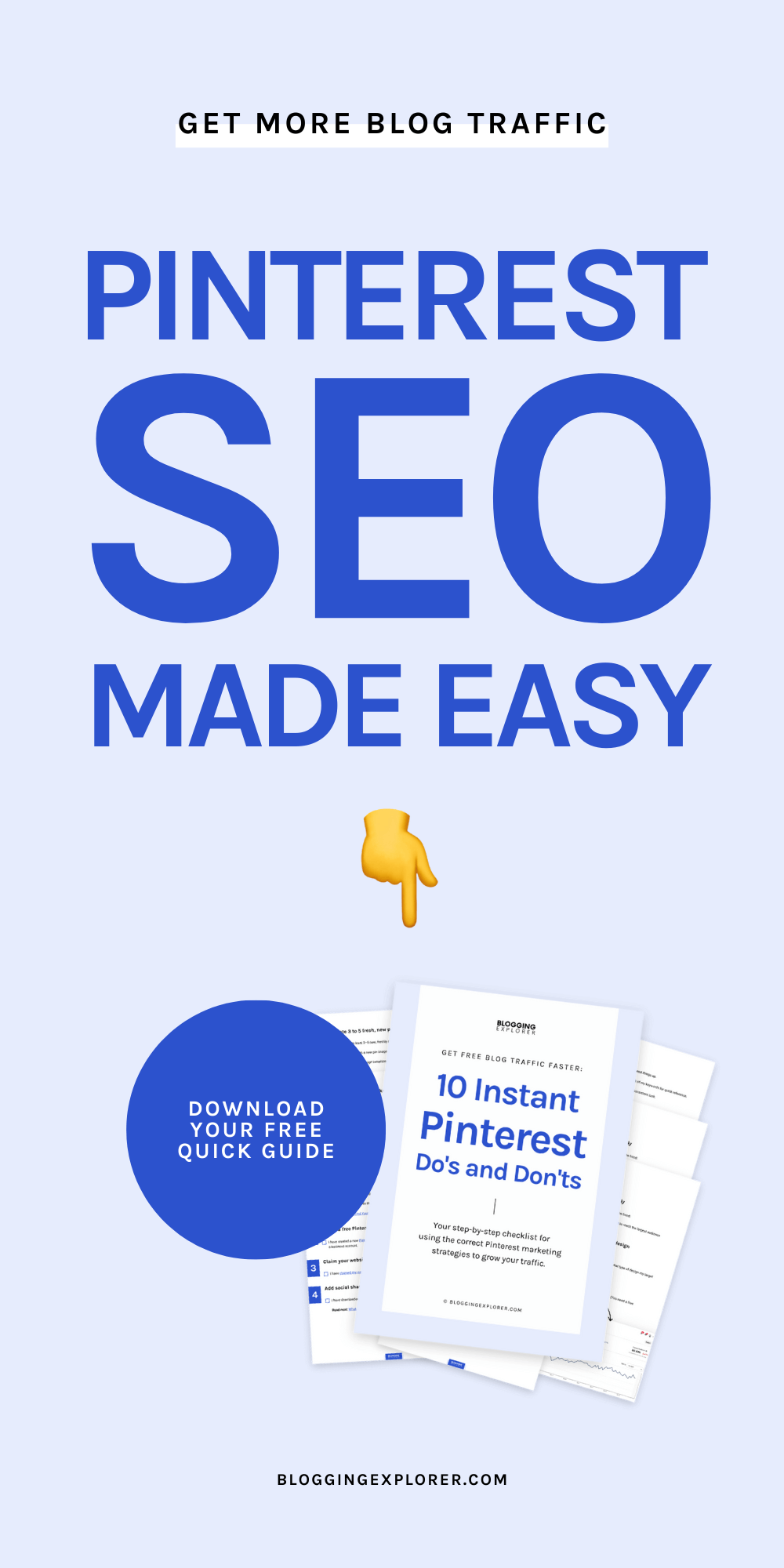Pinterest SEO is one of the easiest ways to grow your blog traffic and make more money online. Especially if you’re new to blogging, knowing how to build a powerful Pinterest marketing strategy is often the quickest way to generate free traffic to your blog posts.
Back in 2019, I had the opportunity to attend the official Pinterest Story Pin Launch Event in Berlin.
That was years ago, but I walked away with tons of hush-hush insider tips for Pinterest search engine optimization.
Based on the recommendations I got directly from the team at Pinterest, I tested dozens of Pinterest SEO techniques to find the ones that really worked.
But wait, isn’t Pinterest SEO super technical and difficult?
No, it’s doesn’t have to be. If you’re new to search engine optimization, you’re in the right place.
In this post, I’ll walk you through the most fundamental Pinterest SEO tips and techniques you should use right now to massively grow your blog traffic fast.
Even if you are new to SEO, you can follow along easily. I’ve included practical, hands-on tips and screenshots so that you can work your way through this guide step-by-step.
Let’s get started!
- What is SEO?
- Why is Pinterest SEO important to your blog traffic?
- Understanding how Pinterest works
- Pinterest vs. social networks: Why you should use Pinterest
- SEO basics: How does a search engine work?
- How to get found on Pinterest: Beginner's Guide
- Pinterest search algorithm: How does it work?
- Pinterest keywords: How to find and use them the right way
- Step 1: Find relevant Pinterest keywords
- Step 2: Focus on long-tail Pinterest keywords
- Step 3: Find keywords with Pinterest Ads
- Step 4: Track your Pinterest keywords
- Step 5: Update your Pinterest profile
- Step 6: Create Pinterest boards
- Step 7: SEO your Pinterest boards
- Step 8: Optimize your board sections
- Step 9: SEO your pin titles and descriptions
- Step 10: Optimize your images and text overlays
- Step 11: SEO your blog posts
- Step 12: Use the "data-pin-description" tag for pinnable images on your blog
- Step 13: Optimize your product photo pins
- Final thoughts: The ultimate beginners guide to Pinterest SEO
Disclosure: This page contains affiliate links, meaning I receive a commission if you decide to purchase using my links, but at no additional cost to you. Please read my disclosure for more information.
What is SEO?
Before we dive into the technicalities of Pinterest SEO, let’s start with some basics first.
If you’re familiar with what SEO or search engine optimization is, feel free to skip to the next section.
SEO or search engine optimization is all about making sure your blog posts get matched with the right search queries on a search engine.
People often talk about SEO when they refer to Google. But optimizing your content is just as important for other search engines, too.
Your goal with SEO is to make sure your content gets found by your target audience.
And although we’ll never know the exact technicalities behind ranking algorithms, we can follow common best practices for optimal results.
Most importantly, you should create helpful, valuable content for your audience.
Your readers are looking for answers and information for questions and problems they’re struggling with. As long as you know what they want and deliver just that, you’re golden.
High-quality content is sure to gain momentum on any search engine, including Pinterest. Throughout this guide, I’ll show you exactly how to publish and share it the right way to grow your reach faster.
Summing it up, SEO is all about delivering the best possible search results to your readers. Simple as that.
If you’d like to learn more about SEO, check out my introduction to SEO for beginners for some quick SEO tips you can use right away.

Why is Pinterest SEO important to your blog traffic?
Why should you care about Pinterest and how Pinterest SEO works?
If Pinterest is on your to-do list for driving traffic to your blog, listen up.
People do over 2 billion monthly searches on Pinterest.
With 498 million monthly users, Pinterest is a gigantic traffic source for bloggers and small businesses.

The best part?
Pinterest is still underrated and underestimated by most bloggers and businesses. Moreover, I see tons of online businesses and bloggers using Pinterest wrong – or not at all.
With that said, if you know your way around Pinterest SEO, you can easily leverage it to drive huge traffic to your blog.
And since chances are that your competitors are using Pinterest wrong, it’s a huge opportunity to outdo your competition much faster than with any other traffic tool out there.
Sounds good?
Great! Let’s get started with some Pinterest basics to understand the fundamentals behind SEO on Pinterest.
Understanding how Pinterest works
Before we dive into the actual Pinterest SEO techniques you can use, let’s take a few minutes to understand how Pinterest works. And by this, I mean how their search engine works under the hood.
Yup, you heard right — Pinterest is a search engine.
This is the most important lesson you need to understand before you start learning Pinterest SEO.
Pinterest isn’t a social network, it’s a search engine.
People aren’t looking to socialize on Pinterest. They don’t want to like and comment on each others’ outfits and selfies.
Instead, they’re searching for ideas, information, and inspiration.
And this is where most bloggers go wrong. They think Pinterest is a social network and they start using it like one.
And when they don’t see the results they’re looking for, they quickly become impatient and quit using Pinterest altogether. (Don’t be one of those bloggers!)
Pinterest vs. social networks: Why you should use Pinterest
Ok, so Pinterest isn’t a social network. But what does it mean for you?
Understanding that Pinterest is a search engine has a few key benefits for your blog traffic strategy:
Benefit #1: Pinterest traffic is long-term
When you use Facebook, Twitter, or Instagram for blog traffic, you need to post new content frequently. And when you do, those posts have a short lifespan. They usually generate traffic for a few hours or a couple of days.
Thus, traffic from social media is based on virality and it’s bygones by tomorrow. It doesn’t last – and older posts rarely take off and generate traffic months later.
Luckily, Pinterest is different. When you pin a helpful blog post, your target audience can find it years from now. Thus, every pin you create can potentially have a lifespan months, even years!
I see this happen all the time. For example, here are the stats of a pin I published in October, and it didn’t take off until January:
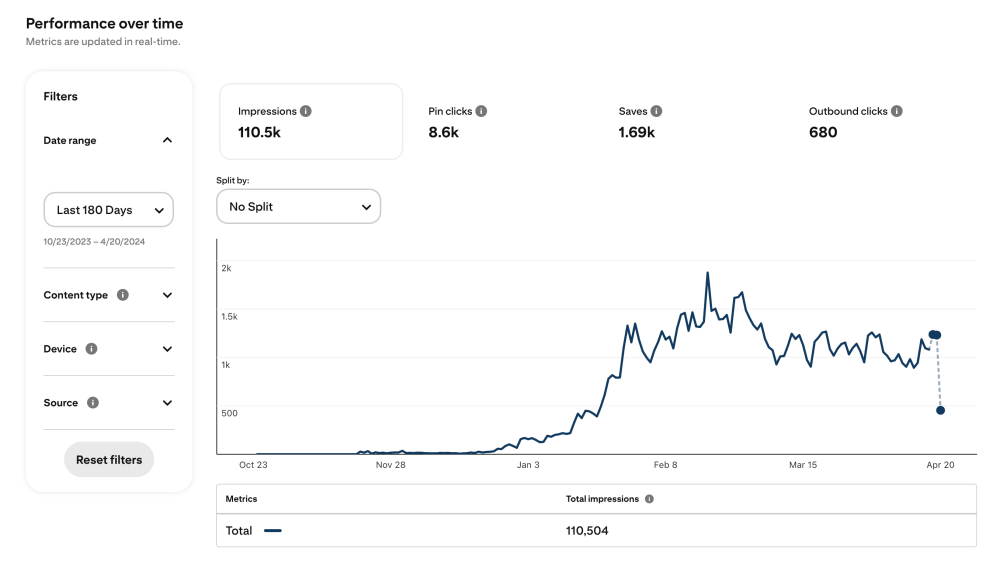
And see how it’s getting consistent views and clicks with no end in sight?
Hence, you may not see significant traffic in the first weeks or months after publishing a new pin. Be patient and you will see results.
Benefit #2: Pinterest traffic ramps up
When you start using Pinterest, you obviously start with zero pins and zero followers. It will take a while to start seeing substantial clicks and traffic. Stay consistent and pin strategically and your traffic will ramp up eventually.
Even though takes a while to gain traction on Pinterest, just stick to your guns and don’t give up. You will see results, I promise.
Benefit #3: Pinterest SEO brings free, organic, consistent traffic
Because it is a search engine, a solid Pinterest SEO strategy will help you grow your blog with organic, consistent traffic.
If you pin consistently over months and years, you can get free blog traffic much more easily than with Google SEO, for instance.
But to get there, you need to understand a few fundamentals of how search engines work. This will help you gain a better overview of how to use Pinterest SEO to drive more traffic to your blog for years to come.
SEO basics: How does a search engine work?
Now, I know SEO may sound technical and intimidating – especially if you’re new to blogging. But don’t worry, it’s not rocket science.
To help you get started, I’ll walk you through a few key points you should know about search engines.
Essentially, all search engines have one mission:
Search engines want to match each search query with the best, most relevant content in their index.
Thus, SEO is all about understanding what your target audience needs and offering them helpful content that makes their lives easier.
But how can you make sure Pinterest shows your pins to the right audience?
Basically, your Pinterest SEO strategy is all about making sure Pinterest understands what your pins are about. After all, pins are simply images, so you need to add some context to them so that Pinterest knows what they contain.
To shed a bit more light on Pinterest SEO fundamentals, let’s take a quick look at how search engines work in general.
(If you’re already familiar, feel free to skip to the next section.)
How search engines work
If you think about Google, their search engine works something like this:
- First, Google “crawls” your blog article, reading its contents and seeing what you’re writing about, word for word.
- Second, Google tries to understand what your blog article is about and how your content could help their users.
- Third, its search engine ranks your article among your competitors based on hundreds of individual factors.
- Finally, when someone does a quick Google search, your article appears in the search results.
Broadly speaking, Pinterest works exactly like Google. Its users search for stuff and Pinterest tries to show the best, most relevant results to each user.
Relevance is all about how closely your pins match your audience’s overall interests and specific search queries.
However, there’s one big difference between Google and Pinterest as search engines. Let’s take a look.
How does SEO work on Pinterest vs Google?
The most important difference between Google and Pinterest is this:
Pinterest is a visual search engine, whereas Google is mostly text-based.
Each pin you publish is simply an image, right?
So when you publish a pin that links to your blog post, how does Pinterest know what that article is about?
Whereas Google can read your entire blog article to determine what it’s about, Pinterest starts with the information you include in each pin.
With that said, you need to help Pinterest understand what your pin and blog post are about. Otherwise, you might create hundreds of pins without generating any substantial traffic to your blog. Not cool.
Now that you know how Pinterest works under the hood, let’s look at where your content can be found on Pinterest:
How to get found on Pinterest: Beginner’s Guide
Before we can start doing Pinterest SEO in practice, we need to look at the different ways Pinterest distributes your pins.
Right now, there are two essential ways to get found on Pinterest:
- Smart Feed (or Home Feed)
- Search results
Let’s start with the Smart Feed!
1: Smart Feed or “Home Feed”
The Smart Feed is the first thing you see when you open Pinterest.

Here, the pins are NOT shown in a (somewhat) chronological order like on Instagram, Facebook, or Twitter.
Instead, Pinterest wants to show you curated content you might be interested in. (After all, they want you to spend as much time on the platform as possible.)
To rank and prioritize interesting content for you, Pinterest uses the Smart Feed algorithm. It scores each pin based on relevance and overall quality.
Thus, when you publish new pins, they get scored and Pinterest starts displaying them to other users.
To be exact, the pins you see when logging in to Pinterest are based on:
- Boards you’ve recently pinned to
- Your favorite topics
- Pins you’ve interacted with recently
The first two are self-explanatory. But the third one is more interesting. It explains why you sometimes see pins in your feed that look exactly like something you just saved to your boards.
2: Search results
Whenever your potential readers search for something on Pinterest, you want your pins to show up in the search results, right? That’s the only way to get them to click on your pins and visit your blog.
But how does Pinterest decide which pins to show for a given search query?
How can you make sure your pins are shown to as many users as possible?
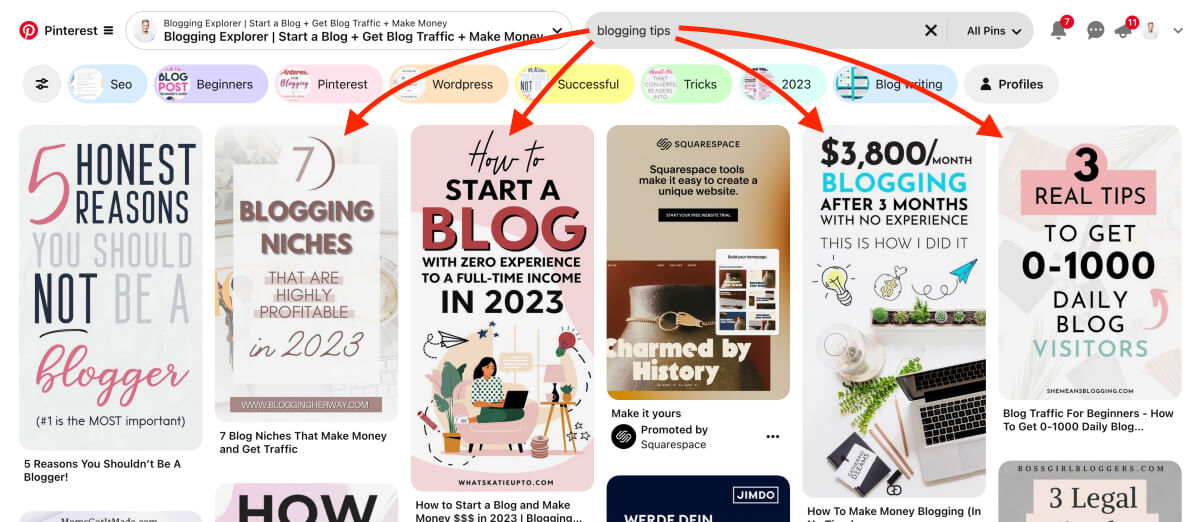
Here’s how it works:
Just like any other search engine, Pinterest uses a combination of individual ranking factors to distribute your pins to the users. This is what we call a search algorithm.
If you’re new to search engines and you’ve never heard of algorithms, don’t worry.
You can think of an algorithm as a set of individual rules that filter out any content that’s not relevant for a given search query.
So, when a user types in “cookie recipes” in the search bar, the search algorithm filters out anything that it thinks isn’t related to cookie recipes.
Thus, the user doesn’t see any cake recipes or DIY projects in the search results.
Now, the better you understand how the Pinterest search algorithm works, the more traffic you can generate to your blog or website. Therefore, let’s look at their algorithm in more detail.
Pinterest search algorithm: How does it work?
Of course, we’ll never know the exact recipe for mastering every possible aspect of winning the algorithm game.
However, Pinterest has revealed a few key points you want to understand and consider when you’re planning your SEO strategy.
These are the four main ranking factors in the Pinterest search algorithm:
- Domain quality:
Just like Google, Pinterest scores your overall domain quality. It’s their perception of the quality of your blog website. Broadly speaking, Pinterest looks at how popular the pins from your website are. When users interact with your pins, it’s a clear signal to the algorithm that your site is a source of high-quality content. - Pin quality:
Pin quality is a measure of how popular and current a specific pin is. Again, user engagement is a sign of quality. Pinterest wants users to spend more time on the platform. Therefore, they are looking for signals about what makes users happy. If your pin is high quality, users will be happier and willing to spend more time on Pinterest. - Pinner quality:
This is a scoring Pinterest calculates for evaluating you as a blogger, pinner, and content creator. This includes not just your own pins, but those you pin from other users, too. Pinning actively and consistently is key to improving your score. - Topic relevance (Pinterest keywords):
This is the most important factor for mastering the Pinterest search algorithm. It’s all about finding and using the right Pinterest keywords in all the right places. This helps Pinterest understand what your pins are about and show them to people who are most likely to engage with them.
The bottom line here is: as long as you create high-quality, share-worthy content, pin consistently, and know where and how to use the right keywords on Pinterest, you’re golden.
For a full-detailed guide, head over to my ultimate Pinterest algorithm article. I’ll walk you through everything you need to know about how the algorithm works and how you can make sure your strategy aligns with the most recent best practices.
But before you can publish your first pin, you need to make sure you find the right Pinterest keywords to use.
Since this is the most important step for successful Pinterest SEO, let me walk you through everything you need to know, step-by-step.
Pinterest keywords: How to find and use them the right way
By now, you’re familiar with the four key factors in the Pinterest search algorithm. Understanding each of them will help you create better content for your followers and make sure your pins are shown to the right people.
The first three algorithm factors are about optimizing and improving your overall score and authority on Pinterest. The fourth factor, topic relevance, is more abstract and perhaps a bit tricky to grasp if you’re new to Pinterest marketing.
Earlier in this article, we learned that Pinterest wants to show the best possible, most relevant results for each individual search.
Hence, to distribute your pins to the right audience, Pinterest needs to determine what topic they’re related to and how relevant they are to users interested in that topic.
When you publish a new pin, Pinterest assigns it to a specific topic using keywords.
The better you understand where to find and use the right keywords, the more blog traffic you can generate through Pinterest.
Thus, you can think of topic relevance as telling Pinterest what your pins are about. Simple as that.
But how do you find and use keywords on Pinterest to show them that your content is relevant for a given search query?
Here are 13 key steps for a solid Pinterest keyword strategy for your blog:
- Find relevant Pinterest keywords
- Focus on long-tail Pinterest keywords
- Find keywords with Pinterest Ads
- Track your Pinterest keywords
- Update your Pinterest profile
- Create Pinterest boards
- SEO your Pinterest boards
- Optimize your board sections
- SEO your pin titles and descriptions
- Optimize your images and text overlays
- SEO your blog posts
- Use the “data-pin-description” tag for pinnable images
- Optimize your product photo pins
Let’s tackle each point individually – make sure to save and share this post with others!

Step 1: Find relevant Pinterest keywords
Let’s start with finding the right Pinterest keywords. To drive tons of traffic to your blog from Pinterest, you must be mindful of what your target audience is searching for on Pinterest.
After all, if you don’t know what they need, how can you create the right type of content for them?
Luckily, Pinterest makes it super easy to find out what they’re looking for. This is the most important point to understand in Pinterest SEO – yet you’ll only need a couple of minutes to get it done.
Now, when you think of keyword research, you may be wondering if there’s a Pinterest keyword tool to use.
Luckily, Pinterest makes keyword research much easier than Google, for example.
The best way to find relevant keywords for Pinterest is with the built-in search feature.
To get started, head over to Pinterest. When you start typing in a niche-related query in the search bar, Pinterest will suggest related keywords:
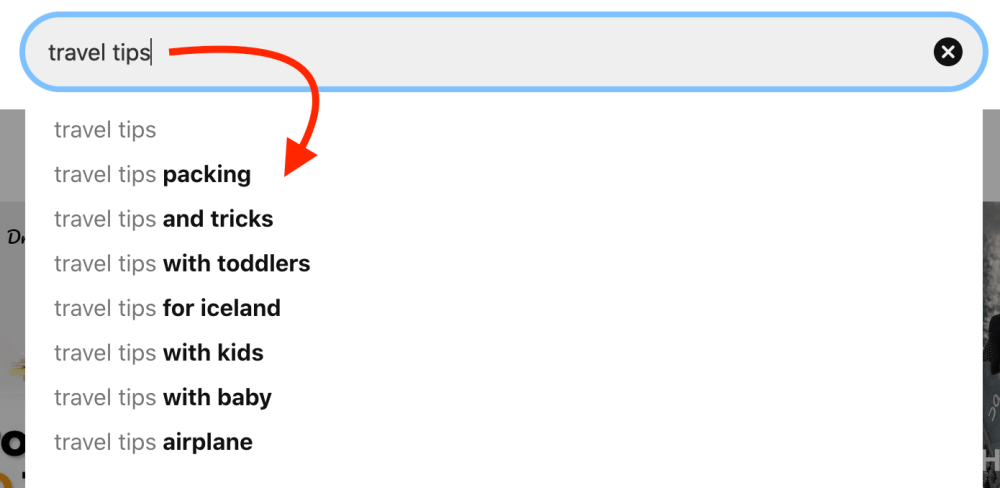
This auto-complete tool is great for finding very specific, long-tail keywords for your blog niche.
All suggested keywords are relevant and popular to your niche!
The autofill features is a fantastic way to discover new blog post ideas, for example.
Step 2: Focus on long-tail Pinterest keywords
To improve your chances of ranking higher in Pinterest search results, you want to focus on long-tail keywords.
Long-tail keywords are longer search queries with multiple words instead of single words, hence long-tail.
For instance, “vegan chocolate cake recipe without gluten” would be a delicious long-tail Pinterest keyword.
The thing with long-tail keywords is that they are easier to rank for than high-level, general keywords.
Not only is there less competition, but people searching for specific ideas are much more likely to engage with your pin.
Again, you can find these keywords directly with the Pinterest search bar.
When you search for a general, high-level keyword, you can add related keywords from the suggestions by clicking them:

This helps you drill deeper into the topic to narrow down your search even further.
Unfortunately, you can’t see the exact search volume for a given keyword on Pinterest.
Nevertheless, you can get a rough idea by looking into Pinterest categories and seeing how many users are following your topic. This can give you a rough indication of the most popular topics and niches.
However, I have one little ace up my sleeve you can use to find keywords with more specific search volumes. Let’s have a look:
Step 3: Find keywords with Pinterest Ads
Even though we can’t see the exact search query volumes on Pinterest directly, there’s a little-known trick to dig deeper: Pinterest Ads.
Now, don’t worry. You don’t need to create a real Pinterest ad campaign. We’ll just use the Ads keyword tool to see what people are searching for.
To get started, log in to your Pinterest business account.
Open the main navigation on the top left, and head over to Ads > Create campaign:
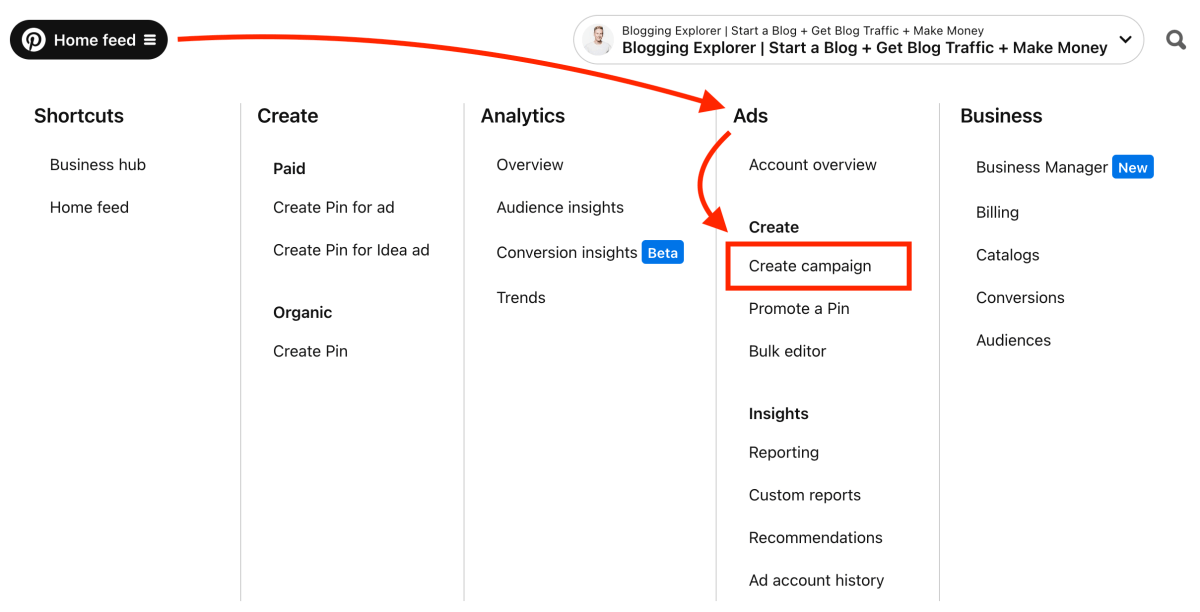
Select Manual Campaign and click Get Started:

Under Drive consideration, select Consideration:
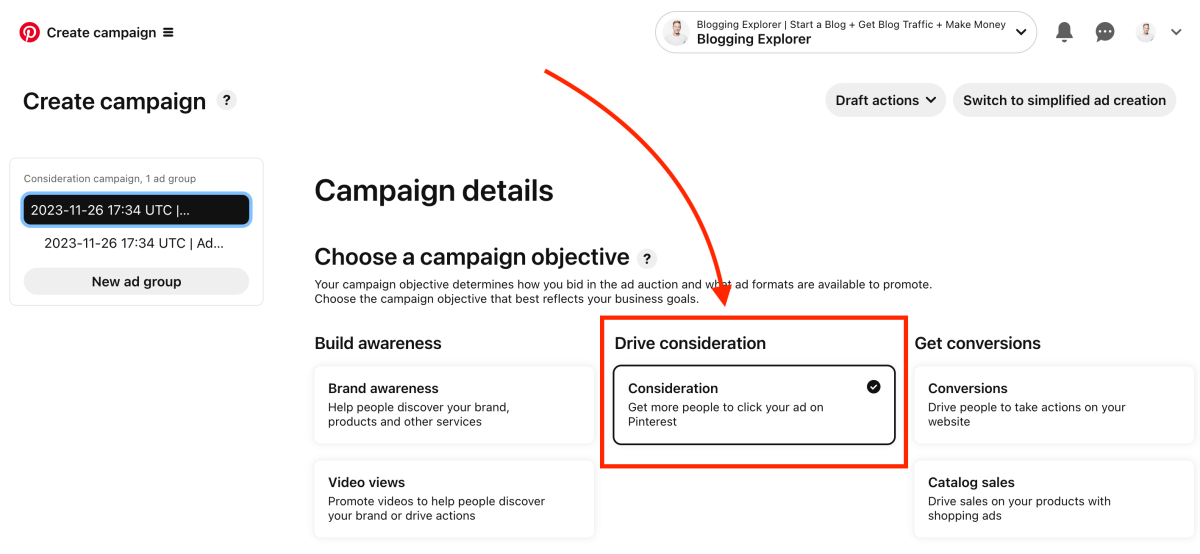
Scroll down to the bottom of the page and click Continue.
On the next page, under Targeting strategy, select Find new customers:
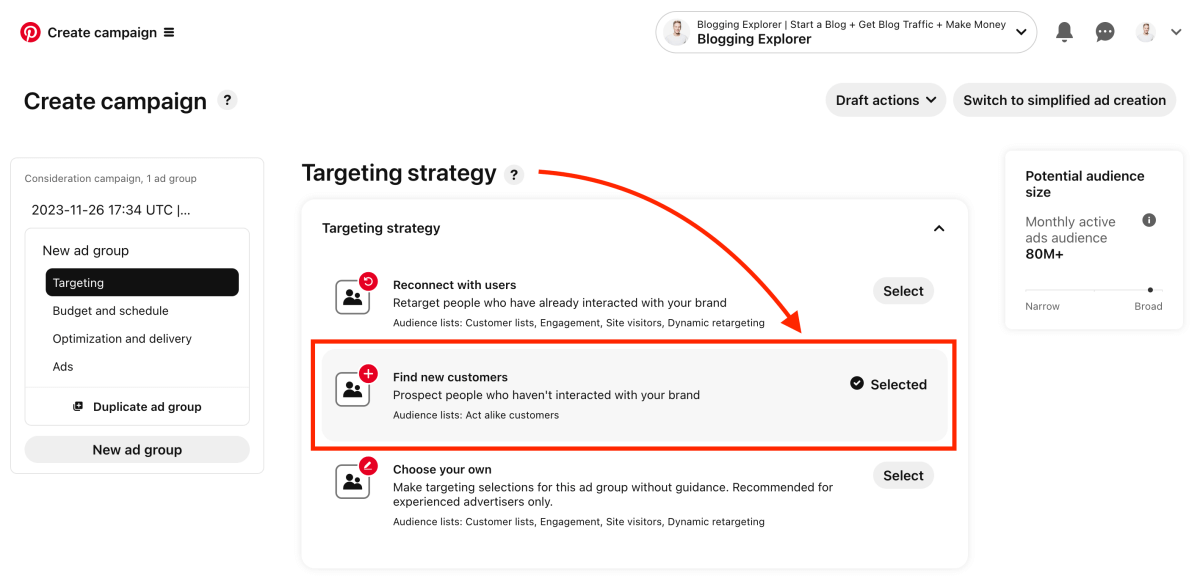
Now scroll down to Interests and Keywords, open the panel, select Add keywords and type in your main keyword into the search bar:

You will now see related keywords based on your main keyword, together with their estimated monthly search volumes and viewers. Let’s try searching for “dessert recipes”:

You’ll now see a bunch of related, high-traffic keywords.
At first glance, you can see heaps of popular keywords, some of them have over 5 million hits per month.
Hence, these are the best Pinterest keywords you could use for paid ad campaigns.
Pinterest wants businesses to use these keywords. They are the best, most valuable Pinterest keywords that allow businesses to achieve the desired results with their ad campaigns.
So, why not just use these Pinterest keywords right from the get-go in your content?
This Pinterest keyword tool should be your go-to keyword research tool. Use it before you create your boards, pins, and start pinning.
Step 4: Track your Pinterest keywords
Pinterest SEO can quickly become overwhelming when you start finding dozens of keywords for your topic.
To make things easier for yourself, write down your keywords in a tool you feel comfortable with:
- Notepad or journal
- Trello boards
- Coggle mind maps
- Google Sheets
I like to work with spreadsheets, so I use Google Sheets for my keyword lists. It’s easy to group and categorize my Pinterest keywords quickly using columns and tabs.
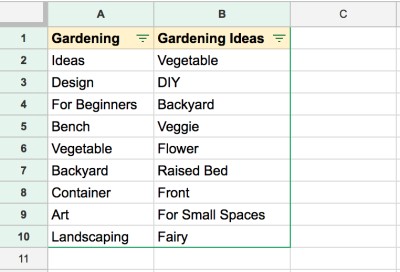
Step 5: Update your Pinterest profile
Although most users won’t find you through your Pinterest profile, you still want to take a couple of minutes to optimize it for Pinterest SEO.
Here are the three most essential places you should use keywords on your Pinterest profile:
Username:
This is the URL of your Pinterest profile. Feel free to add a high-level keyword or use your business name.
Business name:
You have lots of space (60 characters) to add relevant keywords to your business name field. Use them to tell people what you do exactly. This helps your profile show up in search results for People on Pinterest, too.
For example, some of my favorite blogging experts show up for “start a blog” since they’ve used the keyword in their business name:
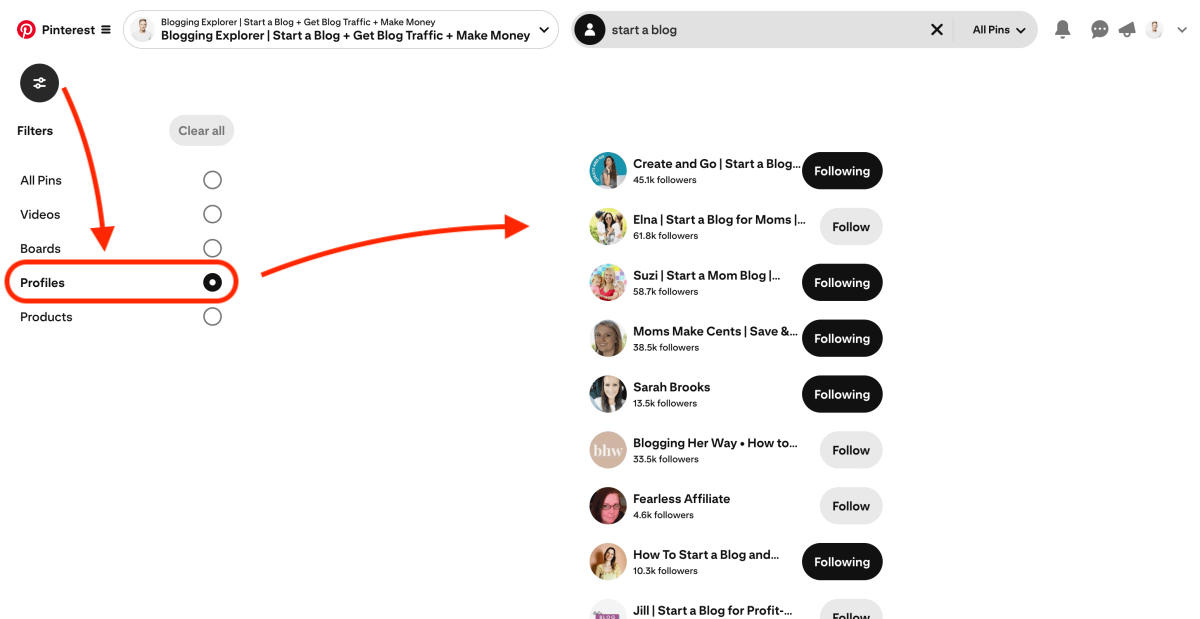
Profile bio:
Finally, you want to use keywords in your bio.
You have 160 characters to use – but it’s surprisingly short when you try to make the most of it. Thus, keep it short and snappy, benefit-driven, and add a simple call-to-action, too.
For example, take a look at Create and Go. They’ve written a fantastic profile description packed with relevant keywords:
“Learn how to start a blog and use our blogging tips to create awesome content, drive traffic to your blog, monetize your blog, and design your days!”
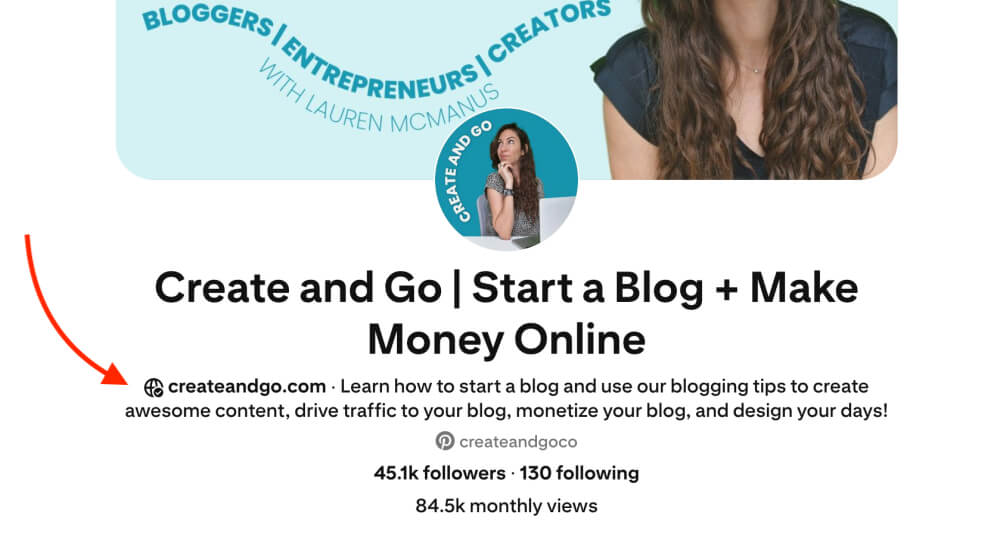
Step 6: Create Pinterest boards
Before you start pinning, be mindful of how you create and optimize your Pinterest boards.
Make sure your boards cover all your blog categories and sub-topics. Also, create three different types of boards:
- High-level boards:
These are broad, general boards for your blog posts. For example, if you blog about “gardening”, your main board should be called “Gardening”. - Low-level boards:
Create several low-level boards with more specific keywords. These can be boards for each of your blog categories, such as “Gardening Tips” and “Gardening for Beginners”. - Long-tail boards:
These will be your most specific, narrow boards based on your keyword research earlier. For instance, “Gardening Ideas for Beginners: Small Spaces”.
That said, boards work and rank just like pins and other content on Pinterest.
People can search for them and also follow individual boards if they’re not interested in all of your content.
Step 7: SEO your Pinterest boards
Next, you want to SEO your Pinterest boards to help the search engine understand what they’re about.
Make sure you use relevant keywords in:
- Board titles
- Board descriptions
- Content on each board
For example, here’s my “How to Start a Blog” board title and description:

When you create new pins, always pin them to the most relevant board first. This is because Pinterest determines the relevance of each new pin using annotations.
Basically, annotations mean that the algorithm tries to find a connection between the board and the new pin.
This helps the search engine categorize your pin and start distributing it to users searching for related content.
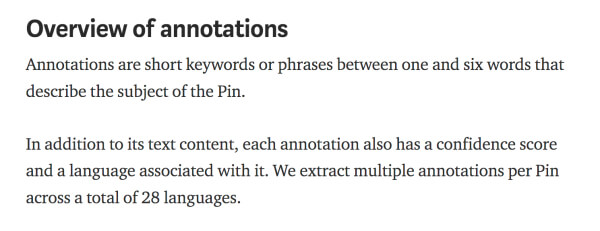
Summing it up, always make sure your board titles and descriptions are relevant to your blog target audience and your blog niche.
There’s no need to be creative here. Just follow these three tips:
- Be clear and tell Pinterest what your boards are about. You may want to repeat the board title and a few other related keywords in the description.
- Never pin unrelated or irrelevant content to your boards. Even if you think someone browsing through your “Vegan Cake Recipes” might be interested in “Vegan Shoes”, you should keep those two separate. Let Pinterest suggest related content to your followers instead.
Step 8: Optimize your board sections
Pinterest board sections are a great way to organize boards with hundreds or thousands of pins.
Board sections don’t have a direct effect on your Pinterest ranking. But you should consider using them. Here’s why:
If you have a few general, high-level boards with tons of pins related to your blog topic, sections can help your followers find what they’re looking for more easily.
Using sections is like having several sub-boards in a single board. They’re great for showing your followers what type of content they’ll find in a specific board.
And when you blog for a few years, your boards can easily have thousands of pins that are difficult to scan through.
When you divide them into logical sections, your followers are more likely to spend more time browsing one or more sections they are interested in.
Step 9: SEO your pin titles and descriptions
When your boards are all set up for Pinterest SEO it’s time to optimize your pins, too.
First, make sure you start your pin title with your main keyword that you’re targeting. This is the most important thing you can do after having created an intriguing pin image.
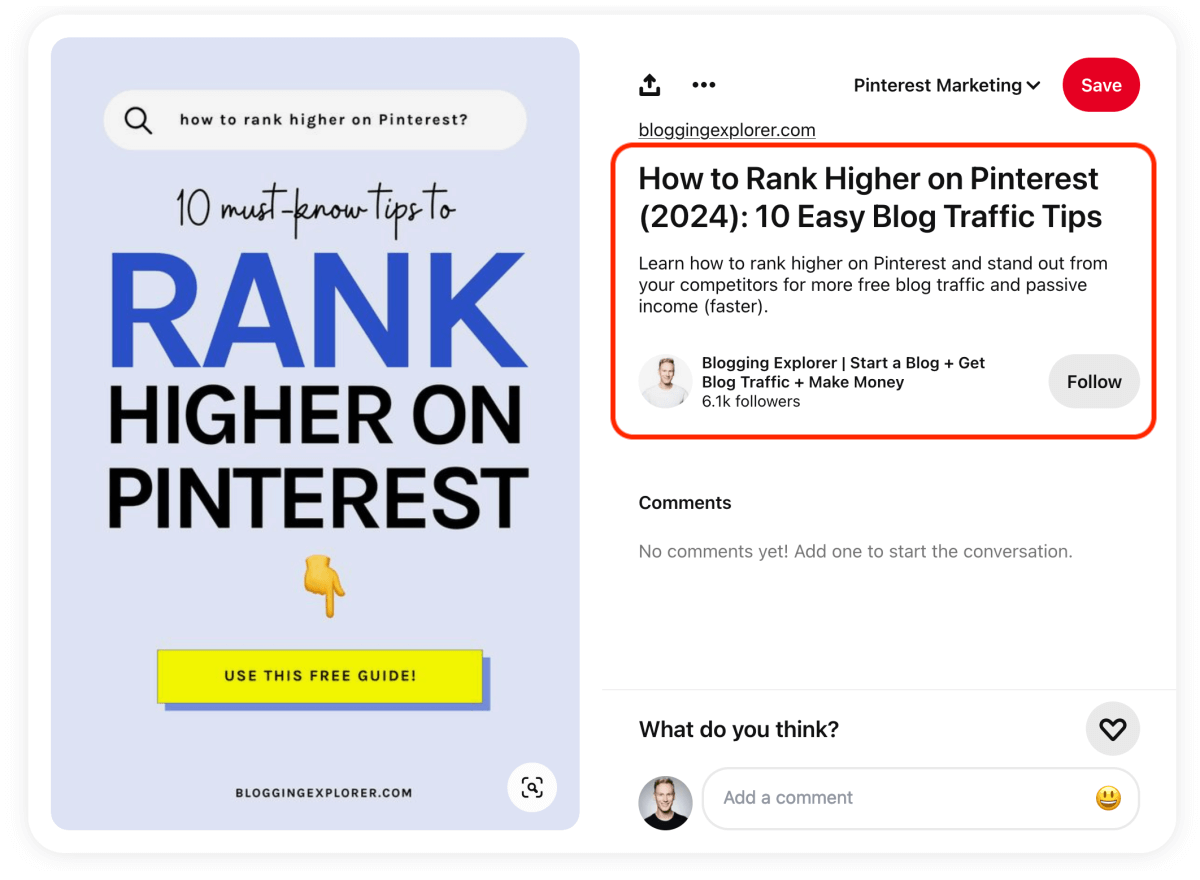
As for pin descriptions, make sure you include relevant keywords and make your description enticing for your target audience.
Most users won’t even see your description, but it’s a fantastic way to help Pinterest understand what your pin is about.
Remember to write pin descriptions that are easy to read. Don’t stuff them with keywords.
Also, make sure you give people a reason to click and interact with your pin. What will they get from your article? Help them understand why they should click through to your website right away.
Step 10: Optimize your images and text overlays
For most blog niches, pins with text overlays perform much better than just an image.
Of course, if you’re selling products on your website, you want to put it in the center of your image and let it speak for itself.
However, if you don’t sell products, keep these points in mind:
- Pinterest can read your text overlay:
Make sure you use a clear, easy-to-read font and a big enough font size. Also, include relevant keywords in your text overlay. - Pinterest can see what’s on your photo:
In 2017, Pinterest launched a visual search feature called Lens. It allows users to find similar products and pins based on what Pinterest thinks is a match. - Users are looking for value:
Use benefit-driven text overlays that highlight the value your readers get from your articles. Never overpromise, always over-deliver – that’s the best way to get users to save your pins and share your content.
For more details, make sure you check out these Pinterest creative best practices.

When your Pinterest account starts to grow, you may want to stick to a cohesive look and design for your pins. That way, your readers can spot your pins more easily in their feeds and click through to your blog.
Step 11: SEO your blog posts
Pinterest SEO is best paired with a set of powerful but easy SEO tactics for your blog posts.
If you’re just getting started with blogging, I know SEO may sound somewhat intimidating.
But as we discussed earlier, it’s all about helping search engines like Google understand what your blog articles are about.
That way, they’re more likely to be displayed to the right audience when they search for a given topic on Google.
Here are a few key points you should consider when doing SEO on your blog:
- Blog post titles:
Your blog post titles get pulled to your rich pin titles. Hence, a good title can help you rank better on Pinterest, too. Make sure you start your post title with your main keyword if you can. - Article body:
SEO is all about organizing your content in a way that makes sense for your readers. Stay focused on your topic and plan out your blog post before you start writing. Figure out what you want to cover in your article in advance – this will help you stay on topic when you start writing. Use sub-headings, lists, and summarize your key findings briefly in your conclusion. - Meta title and description:
If you’re using the Yoast SEO plugin, you can easily add a separate meta title and meta description to your blog posts. That’s what Google will display in their search results. When I start planning an article around a specific keyword, I always look at what types of meta descriptions perform well on Google.
Pinterest looks at your blog post content to determine what it’s about. Hence, learning the basics of what search engine optimization or SEO is about is super helpful for not just your Google rankings but also for your Pinterest traffic.
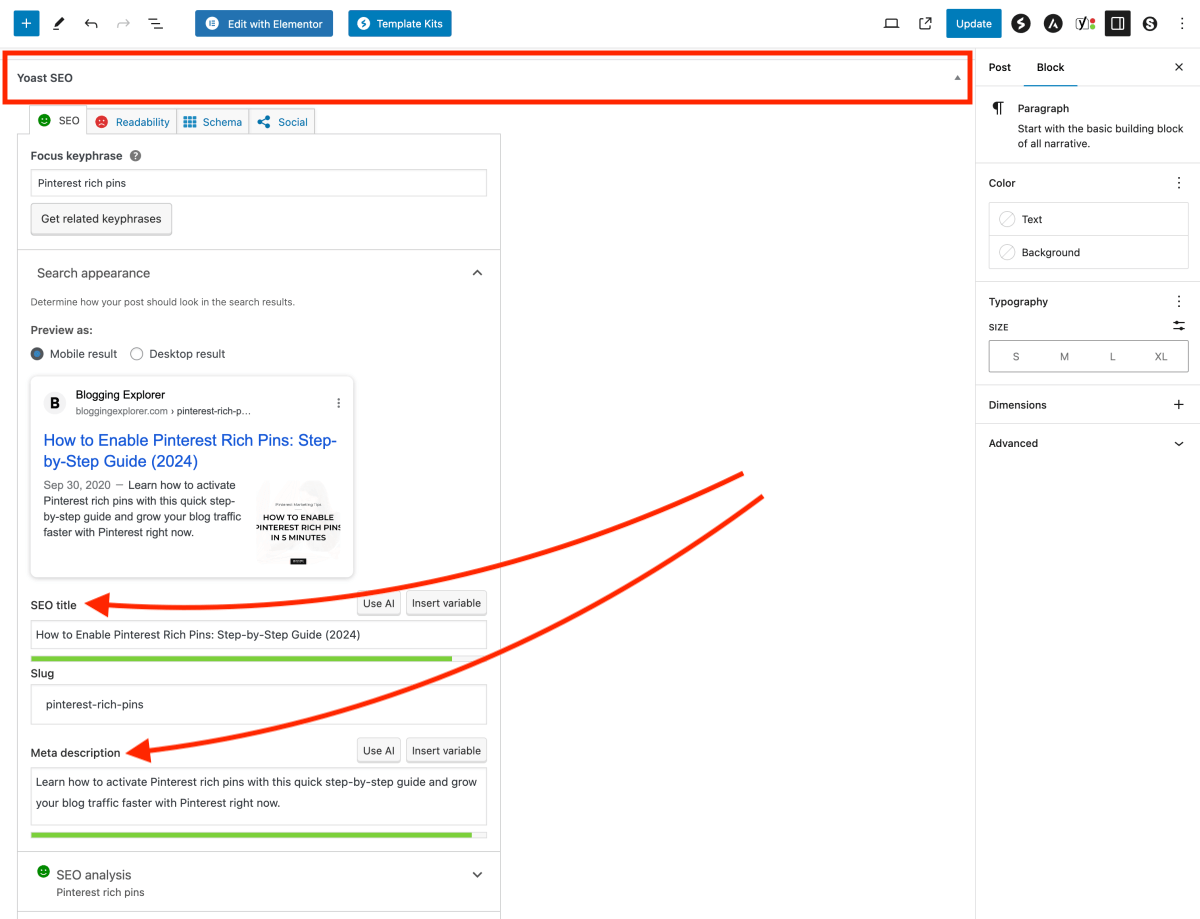
Step 12: Use the “data-pin-description” tag for pinnable images on your blog
When people visit your blog, you want them to pin your article to their boards, right?
To make this as easy as possible for them, you should embed at least one pinnable image to each article you publish.
When a visitor pins that image, Pinterest needs to know where to look for the pin description.
Now, usually people use the “Alt Text (Alternative Text)” tag for their pin description. And while there’s nothing wrong with that per se, it’s not the right way to do it.
Alt tags should be used for SEO to describe what an image is about, not what your blog article is about.
Instead, use the Pinterest-specific “data-pin-description” tag. It allows you to write pin descriptions of up to 500 characters, including hashtags.
When your readers pin your image from your article, Pinterest automatically looks for this tag and pulls the right description for the pin.
You can add the HTML tags manually if you feel comfortable with the language.
If you want to save time and make things easier, just use a WordPress plugin. I use the Social Warfare plugin for this and it’s working like a charm so far.
The plugin adds an extra field for writing my pin description directly in my Media Library:
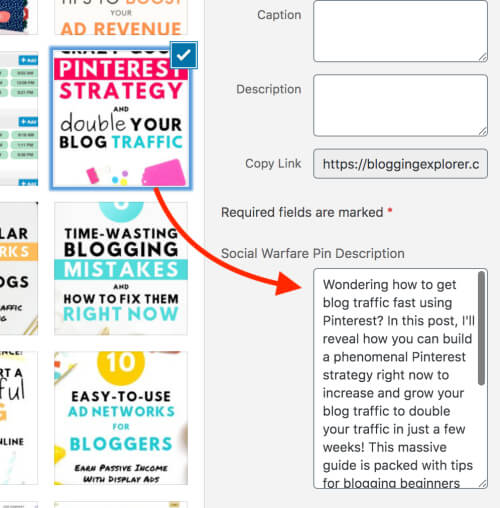
Also, if I don’t want to embed my pinnable image directly into my article, I can easily save one in the background with an SEO optimized pin description for each post I publish:
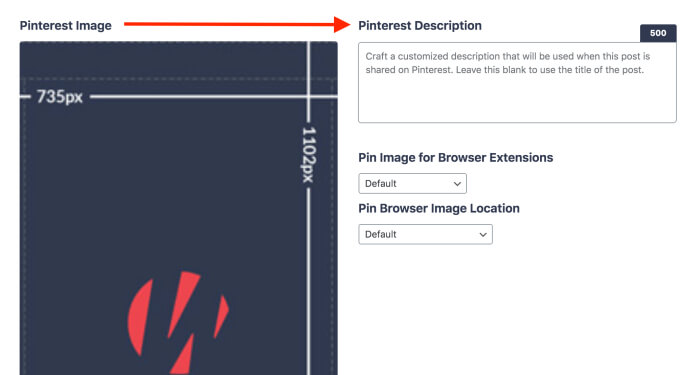
That way, people won’t see the image while they’re reading my post. But when they click the Pinterest share button, they see my image in the suggested photos.
Step 13: Optimize your product photo pins
If you’re using Pinterest to pin products you sell, you must use high-quality photos of your products. This is because Pinterest is becoming better at visual search with their Lens technology.
Lens allows users to point their camera at a product or a piece of clothing. Then, Pinterest identifies the object and suggest similar products and pins.
Thus, make sure you don’t crop your product photos. Use good lighting and avoid using text overlays on top of products.
Final thoughts: The ultimate beginners guide to Pinterest SEO
In this post, we looked at everything you need to know about Pinterest SEO to grow your blog traffic this year.
You learned the basics of how the Pinterest search algorithm works and how you can optimize your boards and pins to have them distributed to your target audience in the search and Home Feed.
Even if you’re new to Pinterest SEO, there’s no need to make things harder than they are. With just a few key SEO tactics, you can drive tons of traffic to your blog or website faster than you expect.
Now, go and review your own Pinterest SEO strategy and see if you can find a couple of points that need some tweaking. Try out the different methods we just discussed for 30 days and see what happens.
Also, make sure you look at your Pinterest Analytics every week to see what types of pins perform well. Use those insights to create more content and more pins that resonate well with your audience.
How are you feeling about Pinterest SEO? How’s your SEO and Pinterest strategy working? Have you used the tips above to optimize your pins? I’d love to hear your thoughts in the comments below!
Here are a couple of related articles you may want to read, too:
- 7 Time-Wasting Pinterest Mistakes You’re Doing (And How to Fix Them Now)
- How to Start a WordPress Blog on Bluehost: Step-by-Step Tutorial
- 10+ Best WordPress Plugins for Blogs (All FREE)
If you found this Pinterest SEO article helpful, drop me a line in the comments section!
P.S. I’d appreciate if you shared this post with others, so that they can find it, too!
